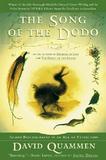
A fantastic book whose only flaw is that it requires the reader to keep track of various storylines.
Let's get my only complaint out of the way. Quammen does a good job of making us feel like we are part of the investigation into island biogeography but he does so by mixing several storylines together. These are the participants, locations and the time they occur, as they occur in the first unit.
Wallace's 1856 trip from Singapore to Lambok
Quammen's recent trip to Lambok
Nicolo di Conti's trip to to the Malay Archipelago
The ark and creation
Wallace's trip (again)
Quammen in Madagascar
Lyle and Darwin in England
Quammen in Madagascar (again)
Charles Lyell's trip 1856, to the Madieras (Atlantic Ocean)
Darwin's Beagle travels 1831
Wallace in Brazil, 1848
Quammen's travels in Brazil, modern
Wallace in Malaysia, 1854
Wallace in Dobo, 1857 Aru Islands -all this in Unit 1!
The book ends with Quammen in the Aru islands around 140 years after Wallace.
Maybe breaking the stories into bite sized pieces makes them more digestible but Quammen's own trip in Malaysia takes about 50 pages and is spread out over 630 pages.
I guess that's the difference between a very interesting book on modern science and a not-so-interesting science textbook. And this book is interesting. Every little piece fits together nicely and explains the subject well.
I like the way the author followed in the tracks of the people he writes about. I certainly felt a bit of a thrill in Australia, inland of Sydney, reading Darwin's account of the Beagle voyage and seeing the same sights he did. He described how he saw convicts working the stone to make steps and around Katoomba, I saw those very steps. I had the same feeling while traveling across Canada and reading a history of Canada. I read it as I crossed the Rockies and really got a feel for how important the railway was - in a way that I didn't in history class.
The subject is the ecology of islands but it is much more than that. Almost any place on earth can be described as an island for various animal groups. National parks in Korea (and elsewhere) are islands of wilderness in an urban or agricultural sea. Caves are islands; how do cave species cross lighted ground to another cave? Mountain tops are islands separated by valleys and valleys can be islands separated by mountains. Lakes are islands and deep areas in those lakes can also be islands, separated from other deep areas by shallow areas. One species of snake described in the book lived only in riffles or fast moving water in a few rivers. Those sets of rapids were separated by slow moving water that was home to larger snakes that preyed on them. Suburban residential blocks are grassy islands that are surrounded by treacherous asphalt
Some animals can travel from island to island. Most birds, but surprisingly, not all, fit this group. Small predators like foxes or (to maintain some connection with target audience in Korea) raccoondogs can also cross from one wilderness to another. Large predators or herbivores cannot. Tigers, bears and deer all have trouble crossing from safe harbor to safe harbor. .
A key part of island biogeography is determining how many species can live on an island. Typically the number of species on an island remains the same even while some species die out and new ones enter. This part of the book reminded me of my biology classes at university where I studied evolution but apparently forgot a lot until this book, much more grippingly, refreshed my memory. If you want to learn about evolution, this is the book.
The other side of new species evolving is older species going extinct. In most of history, the number of new species appearing equaled the number disappearing. Now, the extinction rate has increased 100 times and the end of the book has the required warnings and doom and gloom; "To despair of the entire situation is another reasonable alternative."
I suppose I should strengthen how the content of this book affects Korea. Well, there is a lot about the appropriate size of wildlife parks. Signs at Seorak Park claim there are bears in the park and Chilisan National Park has had researchers trying to find bears there. They may exist but are there enough to maintain a longterm population? As a qualified estimate from the book, a population of 50 is required to maintain a healthy population. I suppose the book could be used as justification for turning the whole DMZ into a park come reunification. Breaking it into farmland or even crossing it with highways will significantly reduce it's usefulness to large-bodied wildlife.
If you are interested in traveling to almost any island, this book will tell you about that island. Again, if you want to understand evolution, this is the book. If you are interested in the pragmatic details of wilderness conservation, this is the book. You can borrow mine, but I will want it back.
Thanks to James for suggesting it.




No comments:
Post a Comment